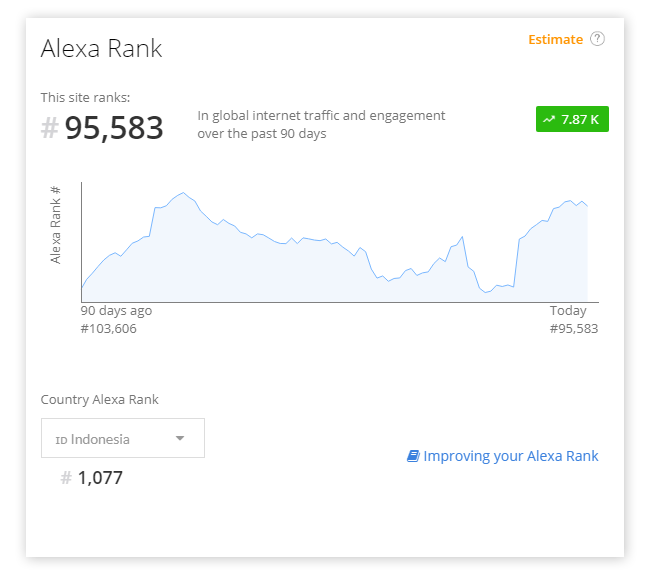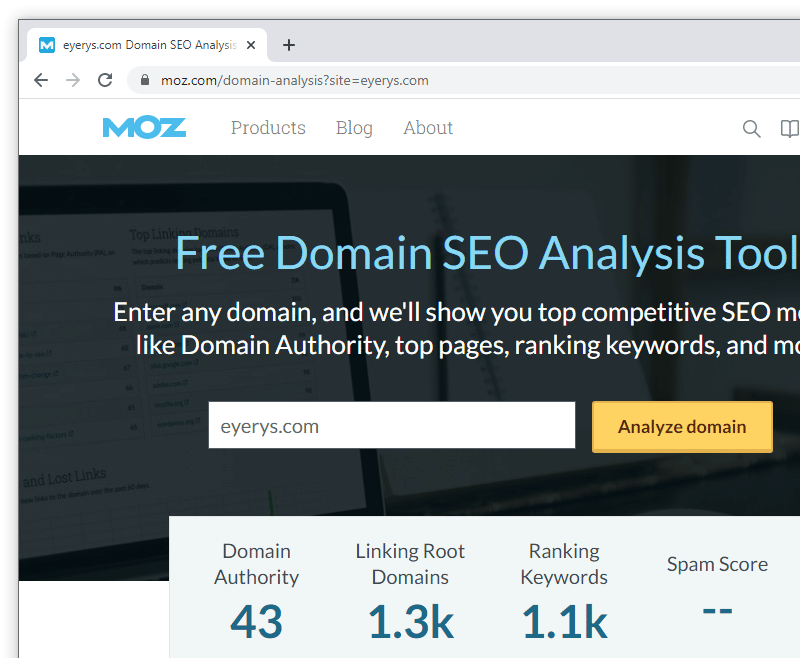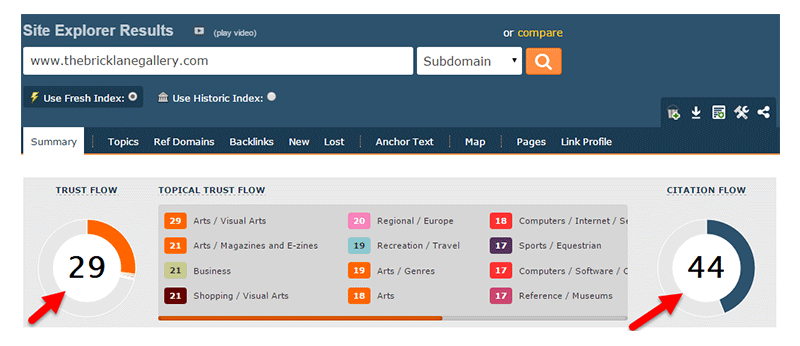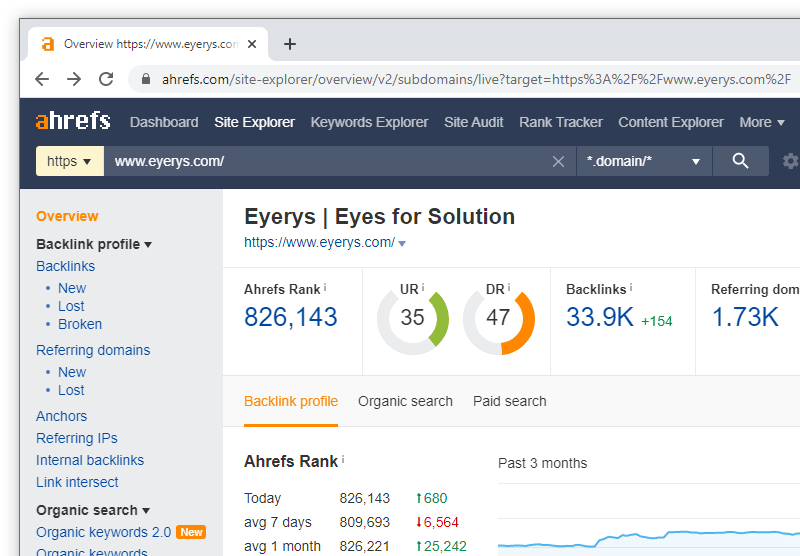SEO is short for Search Engine Optimization.
The term is often used by internet marketers, website owners, webmasters and some others to define the ways to improve the rank and the visibility of websites on search engines.
While there is no exact way to rank high on search engines and using what methods, terms have been used to score them.
The scores are used to judge how good (or bad) a website and its web pages perform on the internet, how high their authorities are, the quantity and the quality of the backlinks, its spam score, and so forth.
Together, these scores are the metrics that can correlate to how a website and its web pages perform on search engines, like Google, Bing, and others.
Google PageRank

Google is the largest search engines of them all, and it's the one that started everything in this SEO race towards the top between websites.
It was PageRank that made Google a search engine in the first place, propelling its way ahead of titans like Yahoo! and other directories of the web.
PageRank uses a voting system as its way to check the quality of pages Google is indexing.
It works by seeing how many websites are linking back to a website. And here, each link is counted as a vote. A backlink from a site with a high PageRank has a much bigger influence in the voting, when compared to a backlink from a lower-ranking website.
PageRank has a 0 to 10 score, with a higher score representing a stronger website.
As Google grew larger and the web became older and more complex, Google isn't relying only on PageRank in order to order results on its results pages. Previously, users of the web can see a site's PageRank by using a dedicated Google Toolbar. But after PageRank having less importance, Google stopped providing this data to the public.
However, PageRank is still the most popular, and is still the best known scoring system from Google.
Alexa Rank

Alexa Rank is one of the older in the list, but still younger than Google PageRank.
In the modern days of the web, Alexa Rank has become lesser known. But still, many SEO specialists and marketers are still relying on this metric to judge the performance of a website.
Alexa Rank is a metric published by Alexa Internet analytics, an Amazon company. The rank is used to describe a website's popularity in the world, and regionally. This is why it's often used to monitor the popularity of a website, and compare it with the popularity of different other websites.
The metric is calculated by the number of traffic a website receives. The higher the traffic, the smaller the number.
DA (Domain Authority)

Domain Authority is the metric from Moz.
It's often used to predict how well a website performs on search engines. It does this by combining other calculations, like Moz Rank, Moz Trust, the number of total links, linking root domains, and so forth. The metric considers lots of signals, and transform them into DA, a one single scoring system.
Moz can tweak the algorithm behind DA to correspond to what search engines are using, in order to determine how well a website is positioned in search engines.
PA (Page Authority)
Also from Moz, is Page Authority.
The score values the quality of the pages of a website that are assessed, and supported by how well the domain is performing on search engines.
In other words, PA is a DA that determines where a web page should be located in search engines' results pages.
DA and PA became popular, most notably after PageRank and Alexa started to have lesser influence in determining SEO metrics.
TB (Total Backlink)
Total Backlink is a score to judge how many backlinks are linking to a website.
Also from Moz, TB scores both dofollow and nofollow backlinks.
QB (Quality Backlink)
QB is short for Quality Backlink.
This score values the backlinks a website gets, by scoring their quality. The metric developed by Moz, scores both dofollow and nofollow backlinks.
PQ (Page Quality)
Page Quality scores the quality of a web page that is the accumulation of the number of backlinks that it has received, and the quality of the backlinks that happened to be on that website.
PQ is given by Page Quality raters who have the responsibility of evaluating “how well a page achieves its purpose”. The score's purpose is to also rank the content, author expertise, links, and brand citations.
MT (Moz Trust)
Moz Trust shows how trustworthy a web page is, when compared to all other pages on the web.
It scores by calculating link trust rather than link popularity. In other words, the more a website gets backlinks from trusted website, like from government websites and university websites, the higher the score will be.
MT can also be measured on domain level (DmT)
MR (Moz Rank)
Moz Rank is almost similar to the Moz Trust, but scores the level of popularity of the website based on the number of visitors the site receives.
Because MR reflects the importance of any web page on the internet, a website's web pages can earn higher MR by acquiring more backlinks from other websites. Higher quality links should provide a bigger impact on MR than links from low-quality websites.
SS (Spam Score)
Spam Score is the accumulation of a score that is considered bad for a website.
To come up with a score, the data can be obtained from various sources, like the DMCA. So if a website is found to have copied its content from others, or have received search engine penalties, this SS score can go up.
SS has 3 levels of scoring.
OS (On, Off Page)
OS is valued in percentage.
It's to show the quality of a website's domain, articles and all that is hosted inside the website. OS values the results of the accumulation.
CF (Citation Flow)

CF is a metric developed by Majestic, used to predict how influential a web page on a website can be, by considering the links that point to it. Here, more links will equal to more influence.
TF (Trust Flow)
TF is a metric for deciding how trustworthy the link is, by considering the quality of backlinks that point to a website. A website can score a high TF if it has lots of backlinks from authoritative websites. In most cases, high TF means that a site features high-quality content. Both CF and TF value range from 0 to 100.
TF is developed by Majestic SEO, and it's similar to Moz's Domain Authority.
While low scores suggest a site to not be "trustworthy," people should always take this with a grain of salt, as things aren't always the case.
TR (Trust Ratio)
TR is Trust Ratio. The score can be calculated by dividing TF with CF.
UR (URL Rating)

The URL Rating is Ahrefs' counterpart to Moz's Page Authority.
This metric started out as a replacement for PageRank, but later, it evolved and became a metric on its own, but with a high possible correlation with Google's ranking system.
DR (Domain Rating)
Domain Rating is Ahrefs' counterpart to Moz's Domain Authority. DR shows how strong is the overall backlink profile of a website.
KD (Keyword Difficulty)
KD that is also part of Ahrefs metrics, is an approximation of how hard it is to rank on the first page of Google Search results for the chosen keyword.
This has a scale of 0 to 100, with a higher the number used to describe the harder it is to rank for the first page.
Conclusion
SEO is a world on its own.
While most people on the web use search engines to input their query and find what they're looking for, website owners and marketers are depending on SEO to increase their chances of being seen by those search engine users.
To calculate their website's performance, they often use the SEO metrics.
The better the metrics, the higher the chance that they will have their websites surface on top of search engines' results pages. And vice versa a low score means that their SEO campaign may not be working as intended.
These SEO metrics are provided by their respective providers of SEO tools. Each and every one of them, has unique ways for determining and calculating the results.
It should be noted that the metrics can overlap. This is why most internet marketers and SEO specialists may only consider to work to improve some of the metrics and not all.
There are also many online tools that put together many of the SEO metrics into one place to provide convenience to those marketers and specialists.